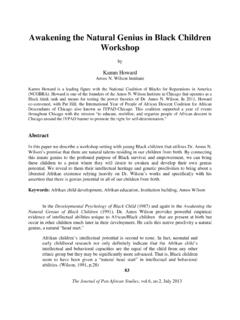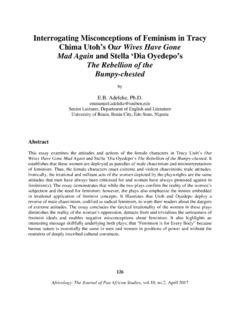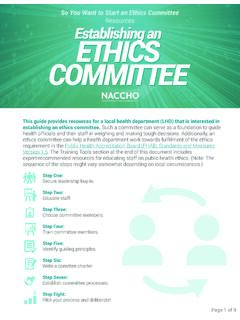Transcription of Environmental Policy, Management and Ethics in Zimbabwe ...
1 Environmental Policy, Management and Ethics in Zimbabwe , 2000-20081 by Fainos Mangena, PhD Department of Religious Studies, Classics and Philosophy University of Zimbabwe Abstract The link between Environmental policy, Management and Ethics has not been adequately explored in Zimbabwe . In this essay, this link is explored to show that while the Zimbabwe government has policies on how the environment should be managed; such policies are not influenced by the desire to respect the moral agency of other beings in the environment other than the moral agency of only human beings. This is so because the constitution of Zimbabwe is silent on the need to respect the rights of beings that are non-human, and this has led to the fostering of an attitude that has resulted in massive Environmental degradation which in turn has resulted in climate change and the reduction of biodiversity.
2 The delay in the re-distribution of land to landless black Zimbabweans coupled with lawlessness has also worsened an already dire situation. This essay argues that if the government wants to address the problem of Environmental degradation; it must incorporate Environmental Ethics in its Environmental Management programmes. Introduction This essay, explores the link between Environmental policy, Management and Ethics in post-colonial Zimbabwe with a view to show that this link is not straightforward and unproblematic. The essay begins by outlining Zimbabwe s constitutional provisions on environment policy and Management , focusing on the old constitution as amended in 2000 and the final draft constitution that was signed into law in 2013. The essay outlines and evaluates the six roles that spell out the objectives of the Environmental Management Agency (referred throughout this essay as the Agency ); an organization that was formed by the government of Zimbabwe to implement the provisions of the Environmental Management Act (EMA) of 2000 (Chapter 20:27).
3 This outline and evaluation is followed by a discussion on the causes of Environmental degradation in Zimbabwe . 224 The Journal of Pan African Studies, , , June 2014 These causes include among others, self-seeking or homocentric attitudes towards the environment and its content, the occasion of the land reform in Zimbabwe and Zimbabwe s economic crisis. These causes will be preceded by a brief discussion on Zimbabwe s pre-2000 land re-distribution and the beginning of Zimbabwe s Environmental crisis. Although the advent of the political crisis in Zimbabwe which led to a haphazard and chaotic land re-distribution had a spillover effect as it somehow affected neighbouring countries like Zambia, South Africa and Botswana, this essay will discuss Zimbabwe s Environmental policy, Management strategies and Ethics with a view to show that Zimbabwe has a unique constitution which is silent on the inherent importance of non-human species in the environment.
4 The essay discusses the rationale behind the government-initiated Environmental Impacts Assessment (EIA) to establish whether or not this exercise serves the interests of all species in the environment. Finally, the essay argues that there is need to integrate ethical programmes in the policy that governs Environmental Management in Zimbabwe . This, probably, involves expanding the Environmental Management Board (EMB) to include people who are experts in Environmental Management Ethics and Veterinarians and animal welfare experts such as those from the SPCA. Zimbabwe Government in Environmental Policy Formulation To begin with, it is important to note that the old constitution of Zimbabwe (amended in 2000) did not have a specific clause that provided for the protection of the It is against this background that in 2002, the government of Zimbabwe promulgated the EMA (Chapter 20:27) and a draft National Environmental Policy in 2003 to provide legal specifications on how the environment would be The EMA was a consolidated Environmental legislative measure which was meant to be the overall Environmental legislation in Zimbabwe .
5 After the promulgation of the EMA in 2002, some acts that had to do with Environmental Management had to be repealed and incorporated into the EMA in order to ensure consistency with the social, economic and political demands of the These were: The Natural Resources Act, 9 of 1996; the Atmospheric Pollution Prevention Act, 31 of 1996; the Hazards Substances and Articles Act, 76 of 1996; and the Noxious Weeds Act, 16 of It is important to note that while the constitutional provisions of Environmental Management in Zimbabwe provided legal specifications, no effort was made by government to come up with an ethical framework that would augment these legal specifications with a view to expand the scope of this policy to include the interests and rights of other important species in the environment.
6 For instance, the January 2013 Final Draft Constitution of Zimbabwe , chapter 4 (Declaration of Rights), section 73, page 46 stipulates that: 225 The Journal of Pan African Studies, , , June 2014 Every person has the right to an environment that is not harmful to their health or well-being; and that the environment be protected for the benefit of present and future generations, through reasonable legislative and other measures that prevent pollution and ecological degradation; promote conservation; and secure ecologically sustainable development and use of natural resources while promoting economic and social The state must take reasonable legislative and other measures, within the limits of the resources available to it, to achieve the progressive realization of the rights set out in this section.
7 What is very interesting to note is that although the chapter on which the section Environmental Rights belongs is entitled: Declarations of Rights, there is no explicit reference to the rights of other species in the environment other than the human species. It is quite easier to infer from this chapter that the prevention of pollution and ecological degradation as well as the promotion of conservation are done, mostly, to serve the interest of human beings. We say mostly, because we are aware that both the prevention of pollution and the promotion of conservational strategies may have a positive effect on both human beings and non-human beings but my point is that since these Environmental mitigation strategies are done in the context of having an environment that is protected for the benefit of present and future generations of human beings, it follows that the benefits that are accruing to non-human beings are only accidental or not really well intended.
8 Below, the essay outlines and discusses the role of the Environmental Management Agency which was established by the Environmental Management Board (EMB) to implement the provisions of EMA. The Environmental Management Agency: Its Policy Implementation Matrix Following the promulgation of the EMA in 2002, section 9 of this Act gave the then Minister of Environment and Tourism the power to establish an Environmental Management Agency (thereafter referred to as the Agency) whose duty was to formulate quality standards on air, water, soil noise, vibration, radiation and waste This Agency was formerly known as the Department of Natural The essay outlines and explains the role of this Agency as follows: To develop guidelines for national plans, Environmental Management pans (EMPs) and local Environmental action plans (LEAPS); To regulate, monitor, review and approve Environmental impact assessments.
9 To regulate and monitor the Management and utilization of ecologically fragile ecosystems; 226 The Journal of Pan African Studies, , , June 2014 To develop and implement incentives for the protection of the environment; undertaking any works deemed necessary or desirable for the protection or Management of the environment where it appears to be in the best interest of the public or where in the opinion of the Agency, the relevant authority has failed to do so; To serve written orders on any persons requiring them to undertake or adopt such measures as specified in the orders to protect the environment: To carry out periodic Environmental audits of any projects including projects whose implementation started before the fixed date for the purpose of ensuring that their implementation complies with the requirements of the The Agency is controlled and managed by the Environmental Management Board which is composed of experts from the areas of Environmental Planning and Management , Environmental Economics, Ecology, Pollution, Waste Management , Soil science, Hazardous substances as well as water and Having outlined and explained [above], the six points that spell out the key objectives of the Agency, the essay will now evaluate each of these six roles to see if they really speak to holistic entities in the environment.
10 With regard to the first role of the Agency, it should be observed that the reference to the guidelines for National Plans, Environmental Management Plans (EMPs) and Local Environmental Action Plans (LEAPS) clearly shows that the Agency has a vision and wants to implement the EMA to the dot. However, this role is not clearly articulated as it raises the following critical questions: For whose benefit are these guidelines? Has the Agency consulted all Environmental Management stakeholders, in its attempt to draw up these plans? My claim is that it is highly unlikely that non-human animals can benefit from the activities of the Agency given the composition of the EMB that excludes critical stakeholders in Environmental Management .









